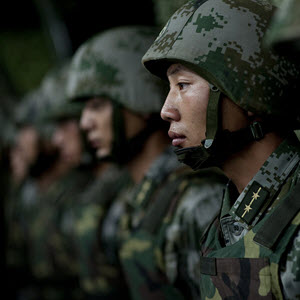2020 People’s Liberation Army Conference
Enabling a More Externally Focused and Operational PLA
On October 26, 28, and 29, the National Bureau of Asian Research, the Strategic Studies Institute of the U.S. Army War College, and the China Strategic Focus Group, Headquarters, U.S. Indo-Pacific Command convened the 28th annual People’s Liberation Army (PLA) Conference online. The theme of the 2020 conference, “Enabling a More Externally Focused and Operational PLA,” examined the PLA’s limited but expanding capacity to operate beyond East Asia within the broader strategic context of China’s transformation from a regional to a global power. The conference’s focus on the continuing evolution of the PLA into a more externally focused and operational force was both timely and policy relevant, given the increasingly global scope of U.S.-China competition.
The invitation-only conference featured keynote remarks by current and retired senior U.S. officials, who drew on their experiences with China-related security challenges. There was a general consensus among participating officials that the PLA, while not yet a global expeditionary force on par with the U.S. military, is an increasingly international actor, with an expanding presence, interests, and relationships that stretch far beyond China’s immediate periphery.
A number of factors have enabled the PLA to expand its ability to operate abroad, including enhanced technological capabilities, deepening relationships with foreign militaries, limited but growing access to overseas military bases or dual-use facilities, and implementation of major structural reforms intended to foster a more integrated joint force capable of conducting a wider, more complex array of missions. Through a series of panel discussions, the conference examined three elements of the PLA’s efforts to become a more externally focused force: relationships with foreign militaries, operational access to strategic geographies, and roles of new or reconstituted services and forces.
The first panel assessed China’s defense and security relationships with states in three distinct regions outside Asia: Europe, Africa, and Latin America. General Secretary Xi Jinping has emphasized military diplomacy as a pillar of China’s overall foreign policy, and the panel identified key overlaps and differences in the PLA’s military-military relations both within and between states in each region. Traditional military diplomacy engagements such as multilateral cooperation on peacekeeping, counterpiracy, or humanitarian and disaster relief operations; port calls; joint training exercises; and professional military education exchanges undergird the PLA’s military-military relations with European, African, and Latin American countries. The arms trade also plays an important role in China’s defense relationships with each region. China is a major arms supplier to Africa, a growing player in the Latin American defense market, and a purchaser, albeit a constrained one, of advanced European military and dual-use technology. There was a general consensus that growing ties with foreign militaries yield additional benefits for the PLA, including opportunities to learn from foreign military forces, acquire intelligence, and enhance cooperation and coordination on transnational security challenges.
The second panel focused on the PLA’s efforts to expand operational access to strategic geographies beyond China’s immediate periphery: the Indian Ocean region, the Pacific Islands, and the polar regions. The PLA’s out-of-area presence is most expansive in the Indian Ocean, but China still faces substantial barriers to undertaking military operations in the region. These include distance from the PLA Navy (PLAN) home ports, narrow maritime chokepoints, and limited access to local support facilities. In recent years, the PLAN has become increasingly active beyond the first island chain, and China’s security activity in the Pacific Islands has intensified. As in other regions, military diplomacy is an important vector for PLA engagement, and the PLAN dispatches regular medical, humanitarian and disaster relief, and training missions to the region. China is also demonstrating a growing security interest in the Arctic and Antarctic. While much of its activity has centered on undertaking scientific research, establishing a presence in the polar regions serves a number of strategic objectives, including obtaining access to geographic points that support more accurate global positioning navigation networks, monitoring the potential emergence of new shipping lanes created by climate change, and improving nuclear deterrent capabilities.
The third panel assessed the impact of recently established or reconstituted services and forces on the PLA’s ability to conduct joint, multi-domain operations (both on China’s immediate periphery and out of area) through detailed case studies of the role of the PLA Rocket Force (PLARF), Strategic Support Force (SSF), and Joint Logistics Support Force (JLSF). While the panelists identified the PLARF, SSF, and JLSF as assuming important warfighting, force multiplier, intelligence gathering, information warfare, and logistical functions within the regional theater command system, the extent to which these forces are involved in out-of-area operations remains limited. For example, “far seas” sealift and other logistics are still primarily undertaken by the PLAN rather than the JLSF.
The final day of the conference included a special discussion of the role of the PLA in the Sino-Indian border conflict, which featured perspectives from leading Indian security experts and U.S. defense officials. The speakers examined the current situation along the Line of Actual Control, assessing the impact of both the PLA’s modernization and its expanding capacity to operate in a difficult geographic region. The speakers also examined the broader geopolitical context of China’s expanding diplomatic and security presence in India’s regional neighborhood in South Asia and considered the implications for U.S.-India security cooperation.
In addition to the three panels, the conference featured breakout sessions led by current and former senior U.S. officials. The participating officials drew on their experiences dealing with China-related defense issues to lead open-ended discussions. This format allowed for direct and collegial interactions among conference participants in a virtual setting.





